Affiliate disclosure: This post may contain affiliate links. Please see our Privacy Policy.
Foraging is a great excuse to get outside and reconnect with nature in the first days of spring. Winter foods are weighing heavy on our stomachs, and it’s time for something fresh…and green. Well before the snowbanks have finished melting into the earth, new life is popping up on every bare patch of soil.
Some of the first plants of spring also happen to be tasty edibles.

Table of Contents
- Chickweed (Stellaria media)
- Ramps or Wild Leeks (Allium tricoccum)
- Yellow Dock (Rumex crispus)
- Day Lilly Shoots (Hemerocallis fulva)
- Hosta Shoots (Hosta sp.)
- Violets (Viola sororia)
- Plantain (Plantago major & Plantago lanceolata)
- Ground Ivy (Glechoma hederacea)
- Garlic Mustard (Alliaria petiolata)
- Wild Garlic or Bear Garlic (Allium ursinum)
- Dandelion (Taraxacum officinale)
- Fiddleheads (Matteuccia struthiopteris)
- Nettles (Urtica dioica)
- Burdock (Arctium sp.)
- Pussy Willows (Salix sp.)
- Japanese Knotweed (Reynoutria japonica)
- Thimbleberry Shoots (Rubus parviflorus)
- Claytonia or Miners Lettuce (Claytonia perfoliata)
- Yarrow (Achillea millefolium)
- Wild Carrots (Daucus carota)
- Linden Leaves (Tilia sp.)
- Tree Sap
- Other Foods to Forage
Chickweed (Stellaria media)
One of the very first spring greens, chickweed often begins growing before the snow has fully melted back in the very early spring. Chickweed is only available in the early spring, as it doesn’t do well in the heat of summer.
It’s high in minerals, and while it tastes a bit bland, it can boost the nutritional content of spring salads. It also makes a tasty, albeit mild, early spring chickweed pesto.
Medicinally, chickweed is cooling to the skin, and it can be used topically on rashes and bug bites. It can also be made into a cooling bath vinegar for dry skin or added to a herbal diaper rash salve.
Chickweed is also an amazing medicinal plant. It contains saponins, which makes it cooling and soothing for the skin. It’s perfect for making into an herbal salve to use on rashes, bug bites, or otherwise dry or itchy skin. I make it into a chickweed tincture for disinfecting wounds.
It’s extremely gentle, and one of the herbs in my herbal diaper rash salve. This chickweed bath vinegar sounds like a nice way to utilize its benefits as well.
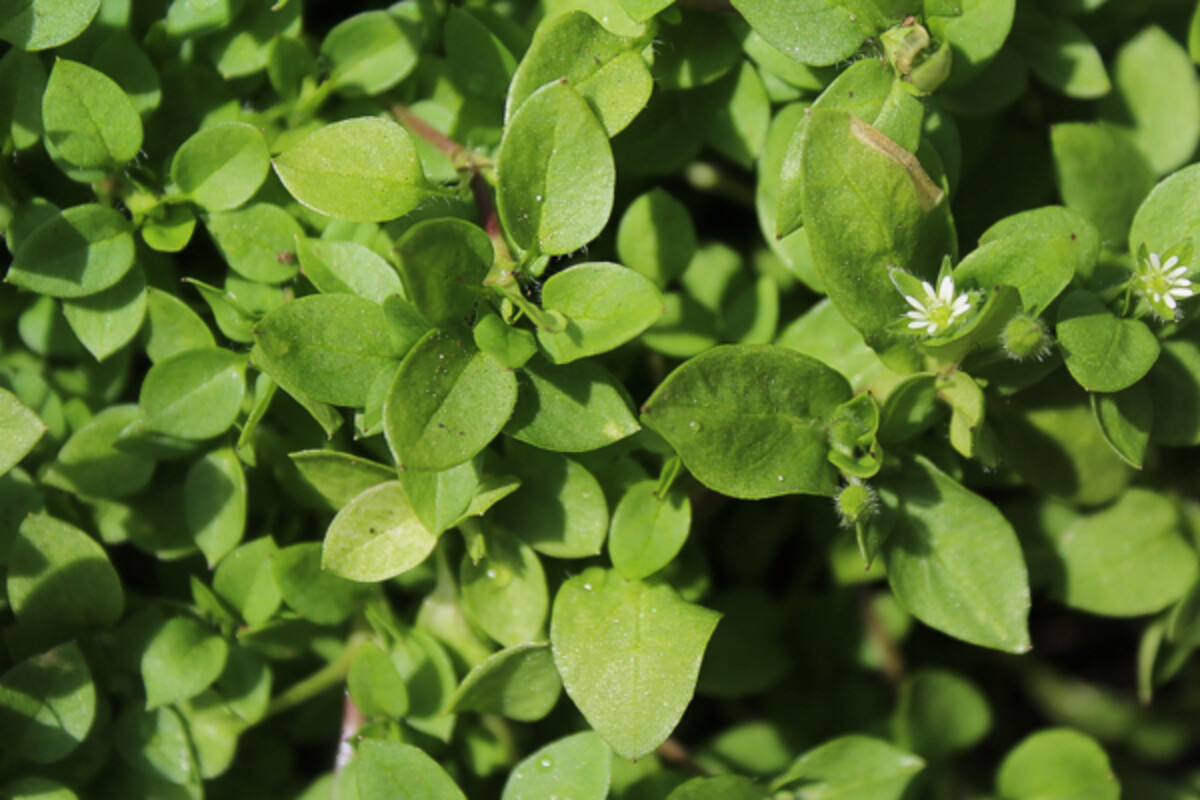
Ramps or Wild Leeks (Allium tricoccum)
Wild leeks or ramps (Allium tricoccum) is known as a spring ephemeral because it grows in shady locations for just a short time in the early spring. The plants pop up and do all their growing before the trees leaf in and provide full shade to the forest soil.
This short growing season means they can take around 7 years to reproduce. The book Farming the Woods (which I absolutely love and strongly recommend reading if you have woods on your land) discusses the sustainability of harvesting ramps and covers a number of studies showing that it’s not sustainable to harvest more than 5% of any given ramp patch in a year. Beyond that, you are causing the population to decline for years to come.
Ramps are relatively easy to establish from transplants or seed, and here are instructions on how to cultivate your own backyard ramp patch. This ensures that you’re the only one harvesting, and you can manage them to only harvest small amounts. That’s the only way to really know if you’re harvesting sustainably.

Yellow Dock (Rumex crispus)
Curly Dock or Yellow Dock (Rumex crispus) is a perennial that returns year after year from a deep taproot. When foraging in the winter or very early spring, you can harvest dried dock seeds and make a nutritious dock seed flour.
Once the snow melts back in the early spring, the roots send up their first leaves. The very young leaves can be eaten in salads or eaten as a cooked green. They are rich in vitamin C, which is welcome after a long winter eating storage crops.
Dock leaves contain high levels of oxalic acid, which prevents the body from absorbing calcium, so they should be eaten in moderation.
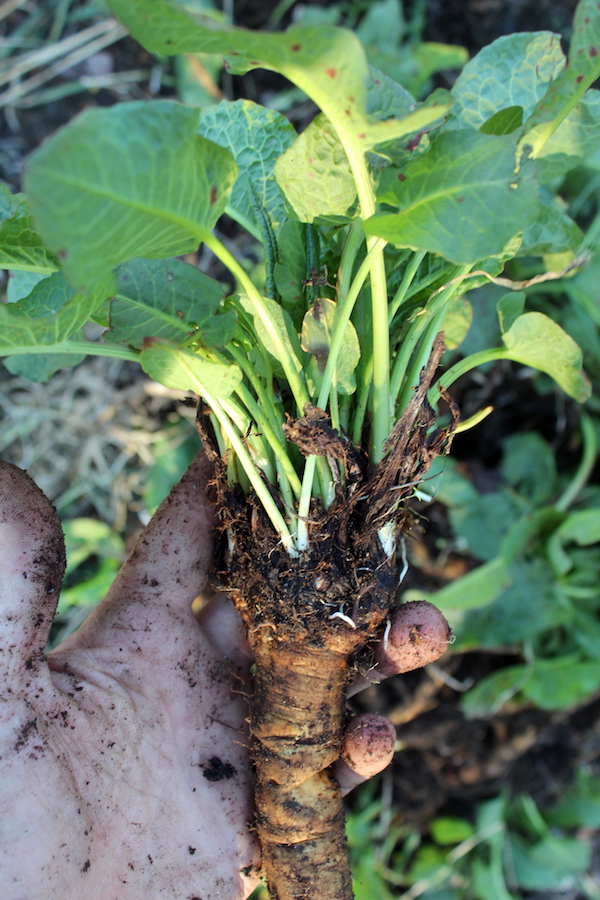
Day Lilly Shoots (Hemerocallis fulva)
You may know that Day Lilly flowers and buds are a tasty mid-summer edible, but the early spring shoots are also edible. Daylilies have been naturalized all over the states, and they can often be found along roadsides and in highway medians up here in Vermont. If you find a patch, make sure you remember to come back midsummer for the real treat, fresh daylily flowers.
Hosta Shoots (Hosta sp.)
So hostas aren’t exactly a wild plant, but if you’re doing a bit of guerilla foraging at a local park or in your own backyard, give hosta shoots a try. They should be tightly curled, and are harvested before they unfurl their leaves. Hosta shoots can be cooked like Asparagus, and taste great wrapped in bacon.
Here’s how to cook hosta shoots with a step-by-step guide.
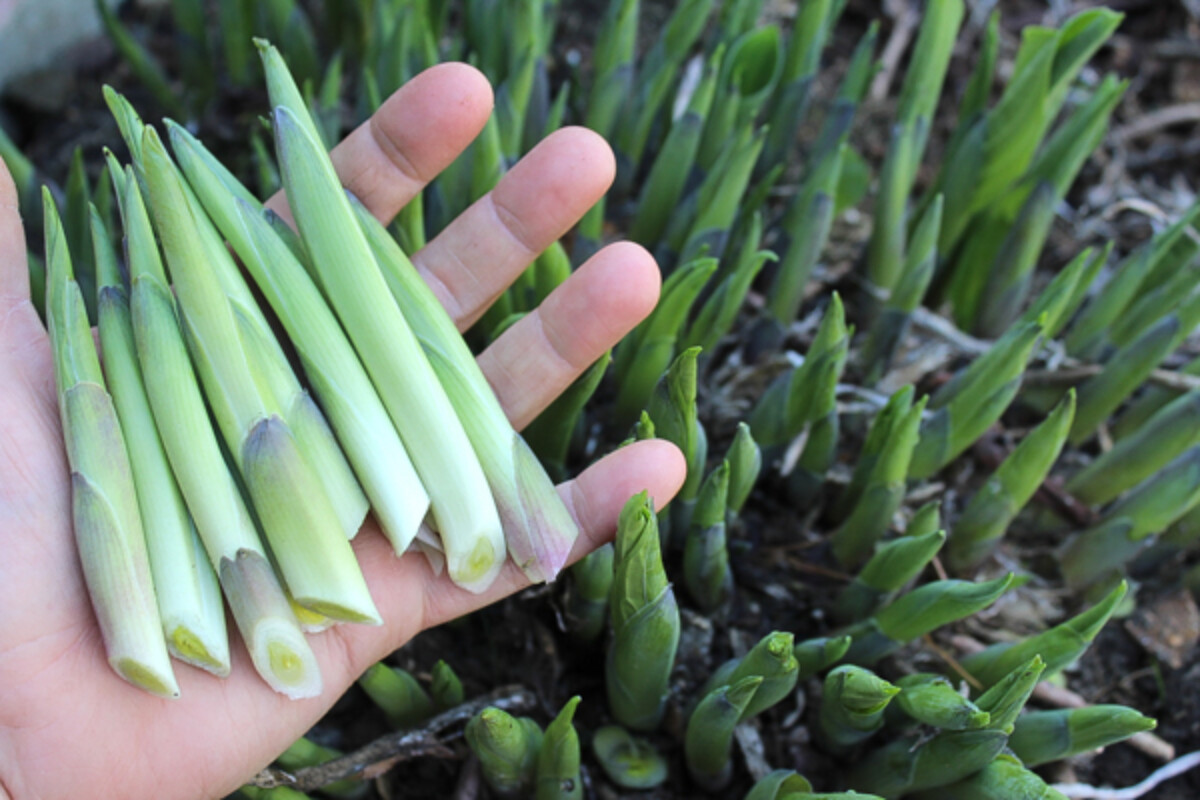
Violets (Viola sororia)
Violets pop up early in the spring and I always love to harvest the blossoms to top my spring salads. The leaves are also edible.
Try using the colorful blossoms to make a bright violet herbal vinegar by infusing the blossoms in vinegar. Check out these ways to use violet vinegar for ideas on how to use it.
Violets are wonderful in springtime sweets, try any of these violet treats:
- Wild Violet Sugar Cookies
- Violet Whipped Honey Butter
- Violet Pearl Tapioca Balls
- Wild Violet Muffins
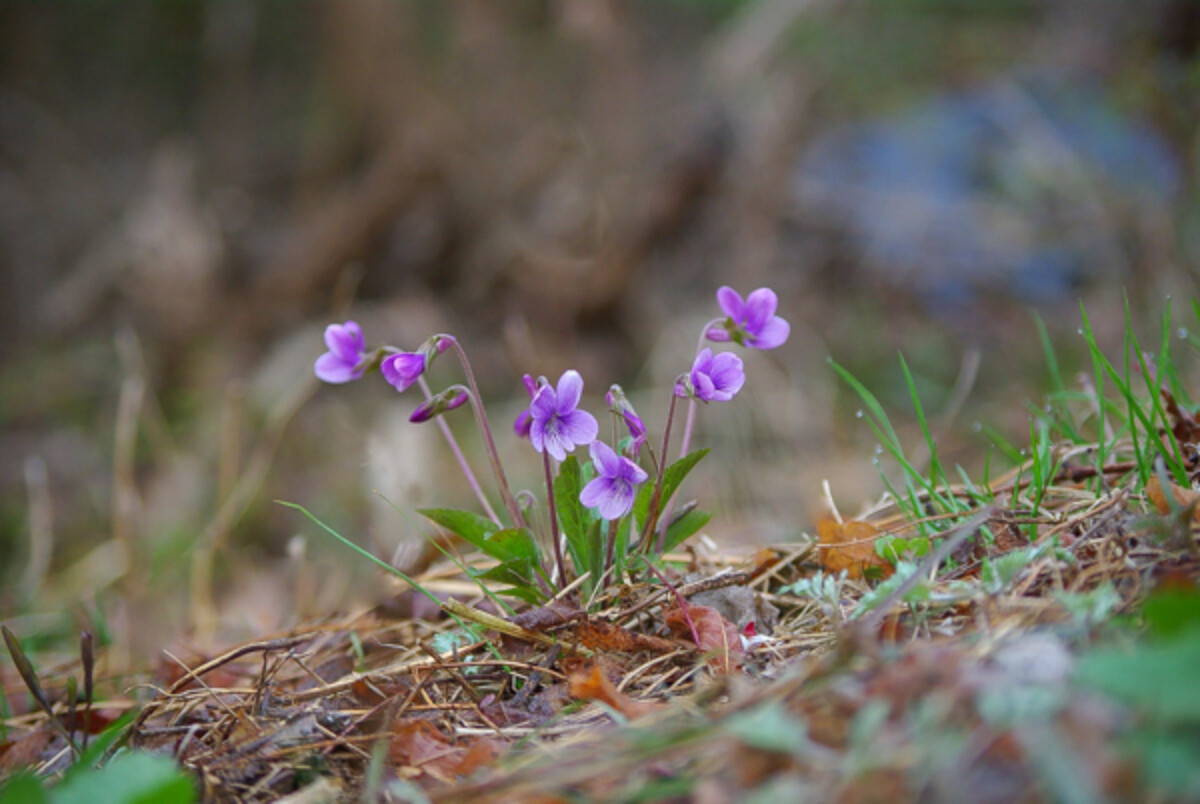
Plantain (Plantago major & Plantago lanceolata)
Most backyard foragers and amateur naturalists know about plantain. It grows everywhere, especially on abused or compacted soils. You’ll likely find it along the most common path you take across your lawn because it can take the abuse of your feet better than standard grass.
It can be made into a quick plantain leaf salve for burns or cooked into plantain leaf chips. Better yet, it can be eaten fresh, just as it is.
Ground Ivy (Glechoma hederacea)
Also known as Gill-Over-the-Ground and Alehoof, Ground Ivy (Glechoma hederacea) is a creeping perennial that starts growing once the snow melts. You can eat it fresh as a salad green or cook it as a potherb.
It gets the name Alehoof from its use in brewing, where it was used to make beer before hops became more commonly used. There’s a great write-up on using it for brewing in Sacred Healing Herbal Brews.
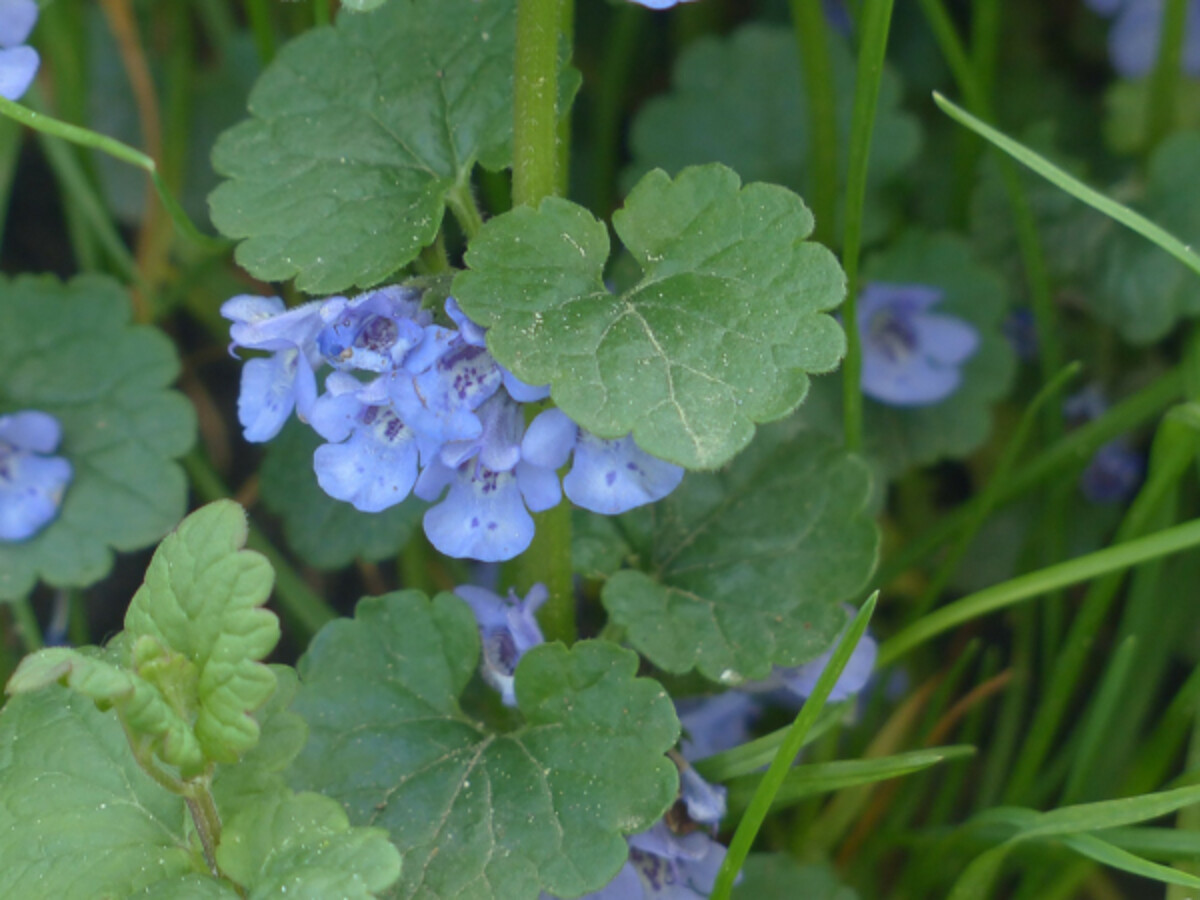
Garlic Mustard (Alliaria petiolata)
Another early spring invasive, garlic mustard is a delicious invasive to combat. It makes a quick garlic mustard pesto long before you can harvest basil from your garden. It can also be eaten as a cooked green or used to season pasta or sauces.
Wild Garlic or Bear Garlic (Allium ursinum)
This one’s a tricky one since it’s only native to Europe and Asia. It looks quite similar to lily of the valley, which is toxic.
I’m mentioning it here for two reasons. One, if you’re in Europe go for it, but be careful! If you’re in the states, you’ll often see it listed on generic foraging guides.
We don’t have it, but we have plenty of lily of the valley. If you go looking for this on you could be courting trouble.
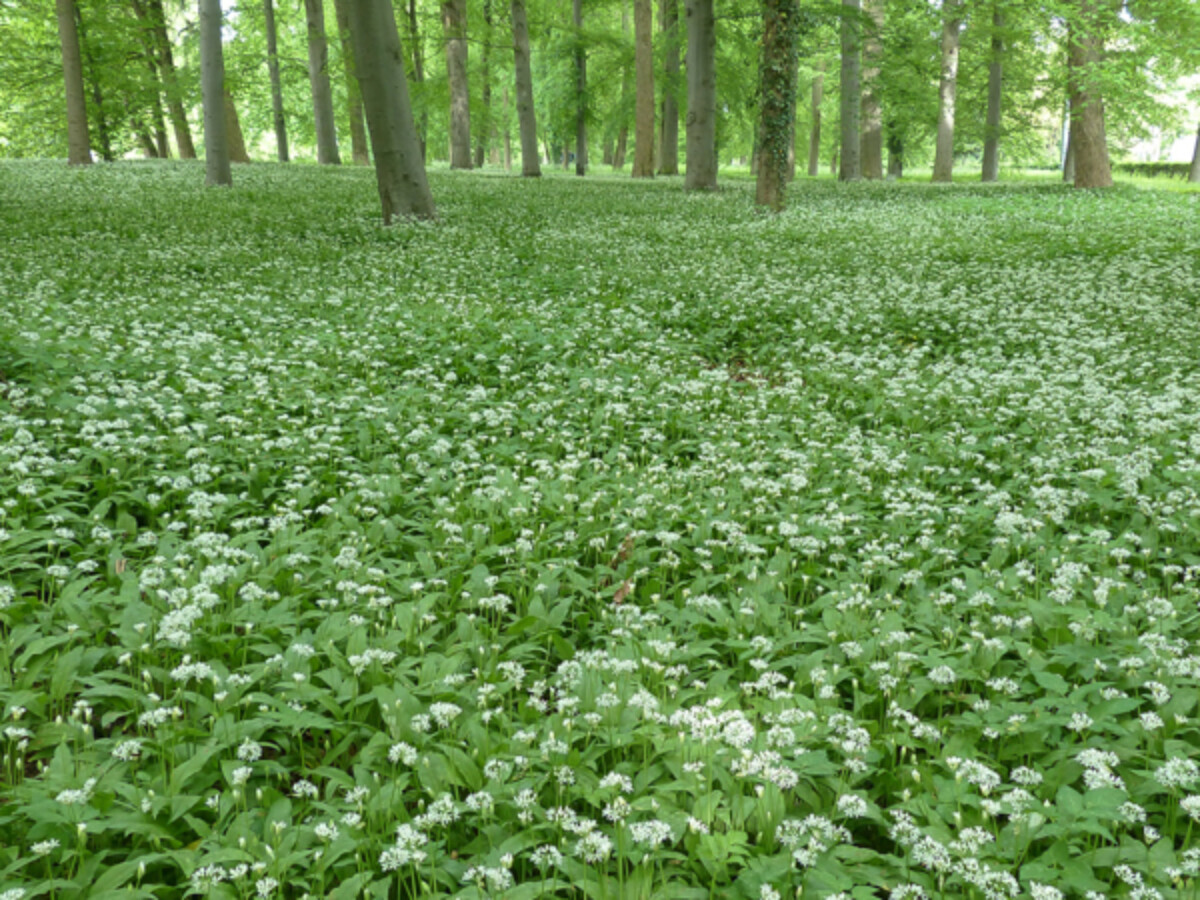
Dandelion (Taraxacum officinale)
These days you can find dandelion greens in the local supermarket, so most people know they’re edible. Try getting creative and making a small batch mead using dandelion blossoms or an old-school dandelion wine.
My little ones love this dandelion ice cream, and the adults in the house are fond of dandelion bud capers. The roots can be roasted to create a tasty dandelion coffee, or you can just cook dandelion roots like carrots.
Medicinally, a dandelion tincture is great for skin and urinary tract issues, or you can try making these dandelion and burdock bitters for use on their own or in a wild foraged cocktail.
Need more ideas? Here are 30+ Ways to Use Dandelions for Food and Medicine.
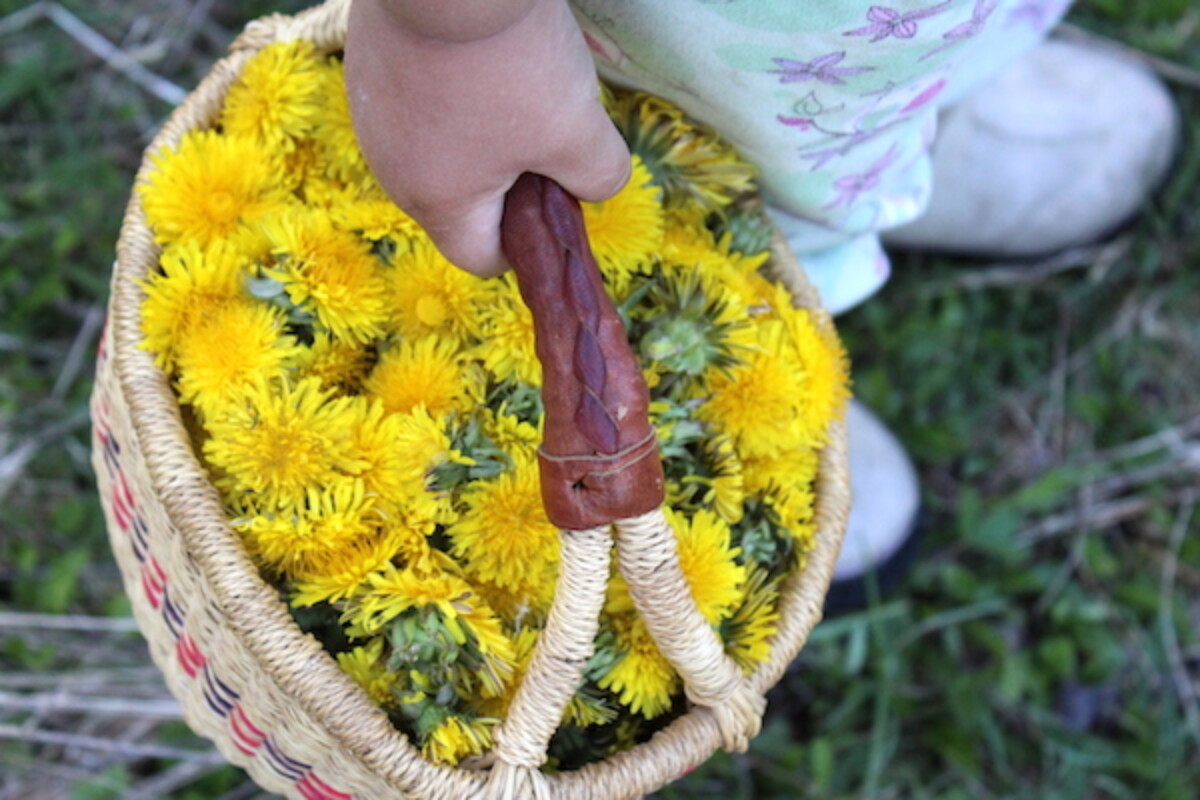
Fiddleheads (Matteuccia struthiopteris)
Ferns are opportunistic plants, and growing in wet, shady areas. By popping up early in the spring they get the benefit of spring sunlight before the trees have leafed-in to fuel their initial burst of growth.
Before the ferns begin to grow, you can find black mounds popping up out of the soil that mark where they grew last year. I’ve had success transplanting those and established my own fiddlehead patch.
Once the fiddleheads begin growing, harvest them early before they’ve unfurled. Be sure not to cut more than 1/3 of the shoots on any given plant.
If you do find a particularly rich patch, pickled fiddleheads are delicious! You can also blanch and freeze fiddleheads for later.
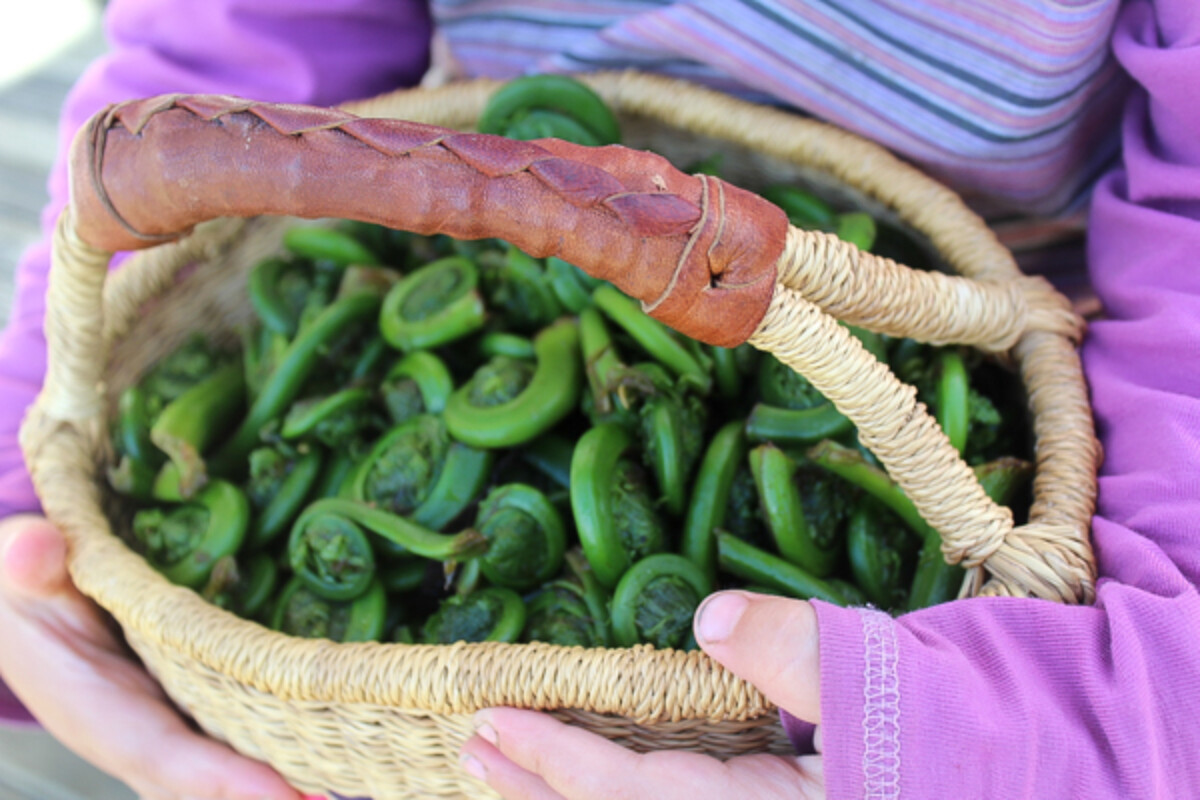
Nettles (Urtica dioica)
I’ll admit I’m not a fan of nettles. I have a vicious reaction anytime they touch my skin, and I’ll feel it for 2-3 days afterward.
You can harvest them with gloves and blanch them to remove their sting. They make a highly nutritious tea, but it tastes a bit like drinking grass. You can tell I’m really in love with them, can’t you?
If you’re feeling more adventurous than I am, try these stinging nettle chips or brew them into a stinging nettle ale.
Burdock (Arctium sp.)
Burdock is best harvested in the late fall of the first year or early spring of the second year. The roots are commonly incorporated into Asian cooking, and there’s a local farm just down the road that sells burdock roots commercially.
No need to buy them, they grow everywhere. Look for the distinctive leaves as they pop up in the early spring and make sure you have a shovel to get digging.
Burdock roots can be cooked like a spring vegetable, and are commonly added to stir-fries. I prefer to make an anti-inflammatory burdock tincture, which has been really helpful a few times when I was sick. Later in the season, burdock leaves and flower stalks are also edible, and I think the tender inside of the flower stalk is the best-tasting part of the whole plant.
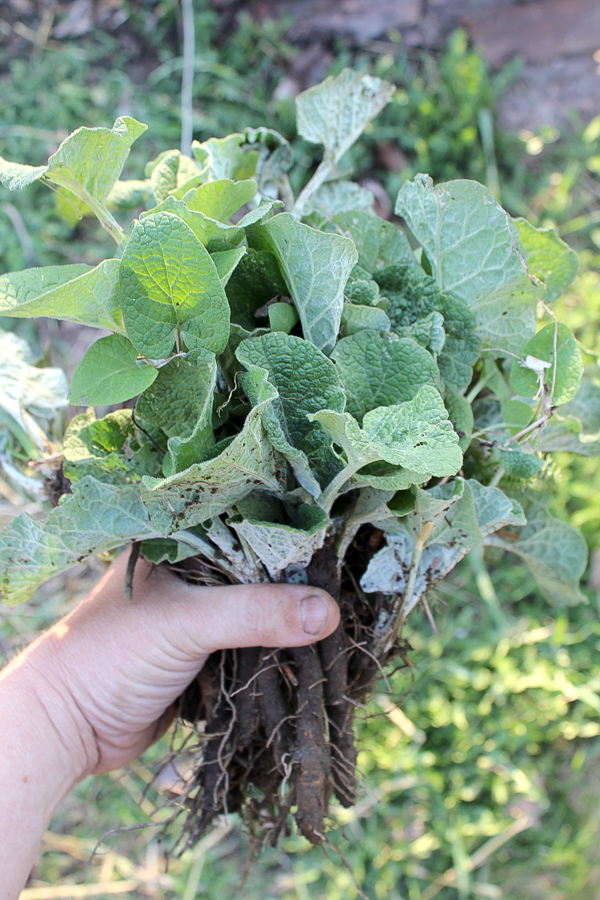
Pussy Willows (Salix sp.)
Easy to identify in the early spring because of their distinctive flowers, pussy willows are in fact edible. The fluffy flowers are just how you identify them, but they aren’t the edible part.
It’s said that all willow leaves are edible, but most just aren’t that palatable. Some aren’t bad, so give the species living near your house a quick try. If they’re tasty, that’s good news because willow leaves are rich in vitamin C.
The inner bark is much more well known, and it’s has been used medicinally for centuries as a pain reliever. Willow bark is traditionally harvested in the early spring when it can be processed into a willow-based wild aspirin.
Beyond just being edible, the book Saanich Ethnobotany describes how the people on Southern Vancouver island harvested willow in early May to make rope, fishing lines and baskets. Here’s a guide on making your own rustic willow basket.
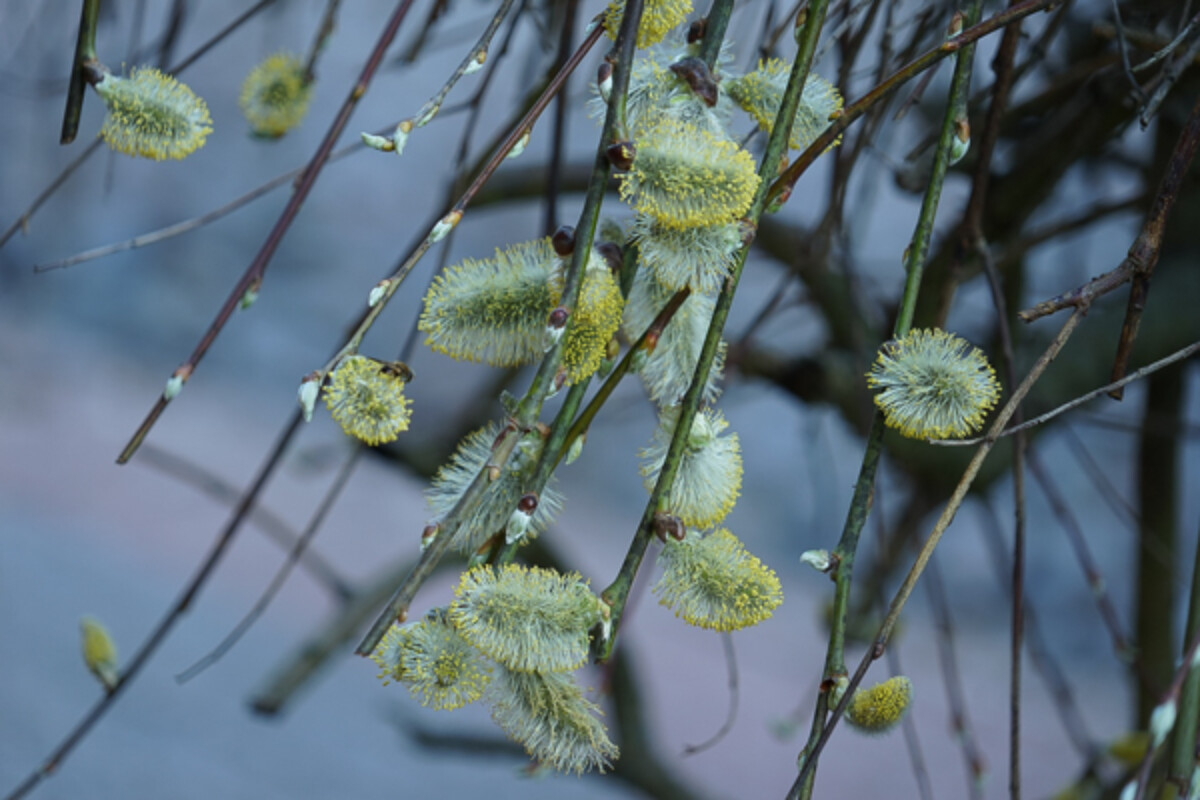
Japanese Knotweed (Reynoutria japonica)
A noxious invasive, there’s plenty of good reasons to eat knotweed. The spring shoots look a bit like asparagus. The most creative way I’ve seen to eat it is as a substitute for rhubarb in a Strawberry Knotweed Pie.
I cooked up a knotweed pie last spring, and it was pretty good. I think to my palate, cooked knotweed loses a lot of its sweet/tart nature and actually tastes more like a green vegetable. I think it’d be better in a more savory quiche.
While raw, Japanese knotweed keeps that rhubarb tart nature, and I made a knotweed-infused gin that was absolutely lovely. The good news is that knotweed-infused alcohol is basically a tincture, and knotweed tincture is used by herbalists to treat Lyme disease. Not a bad side effect in a wild foraged cocktail.
If you need cooking ideas for using up more knotweed, here are 30+ ways to cook Japanese knotweed.
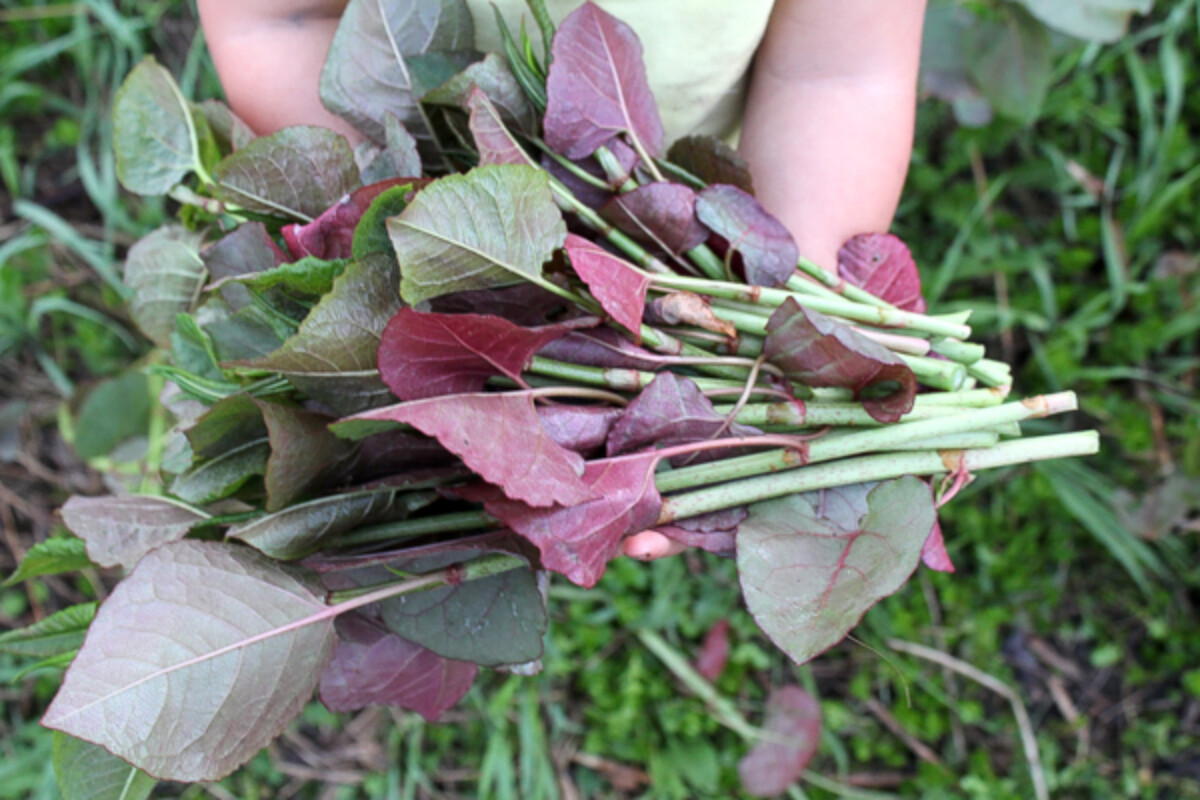
Thimbleberry Shoots (Rubus parviflorus)
I love foraging thimbleberries, and they are a summertime staple around here. They pop up in any shady place with moist soil, like along our house or the stream at the edge of the woods. I recently learned that the early spring shoots are edible, and I’m eager to try them out this spring.
Claytonia or Miners Lettuce (Claytonia perfoliata)
In years past we’ve grown claytonia in our attached greenhouse and it’s kept on growing right through the coldest part of the year. Outdoors, it starts growing even through the snow and can be found very early in the spring.
Some call it the iceberg lettuce of foraging, which is reasonably accurate. The leaves are thick and crunchy, and it doesn’t turn bitter even when it’s in bloom.
Claytonia is common throughout the pacific northwest in the late winter and early spring. Up here in the northeast, you can grow your own claytonia and establish a self-seeding patch at the edge of the woods to forage in the spring.
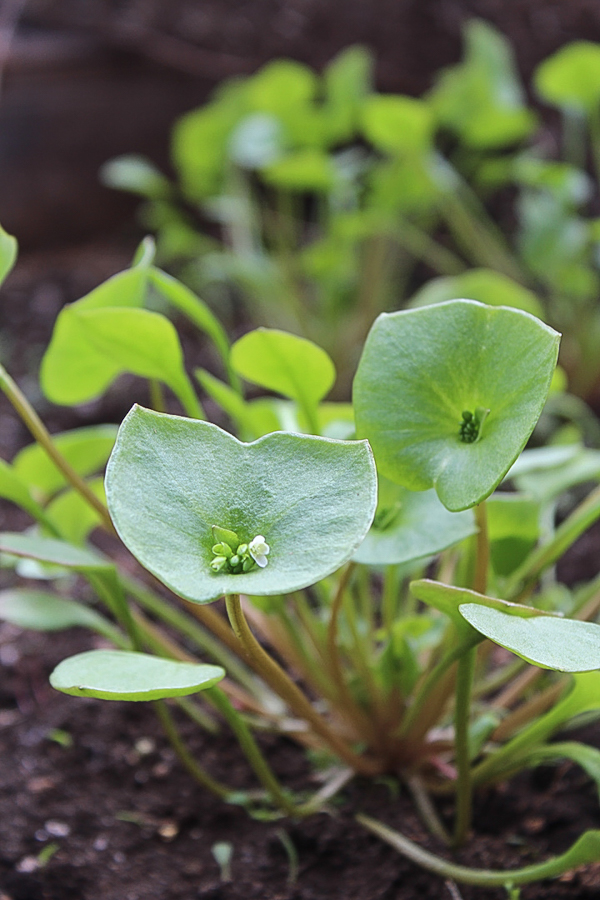
Yarrow (Achillea millefolium)
An early medicinal, yarrow is great for fighting off spring colds. It’s effective at stopping bleeding and can be used to make herbal styptic pencils. The early spring leaves are quite bitter, but they can be eaten raw in salads if used sparingly.
It’s also commonly used as a bittering agent in herbal beers, and there’s a guide to using it for brewing in Sacred Healing Herbal Brews. Topically, yarrow is great for the skin, and it works well in this yarrow and witch hazel soap.
In the early spring, you’ll be harvesting just the leaves. Later on, in the summer, yarrow puts out beautiful white blooms as well.
Here’s a guide to foraging and using yarrow to get you started.
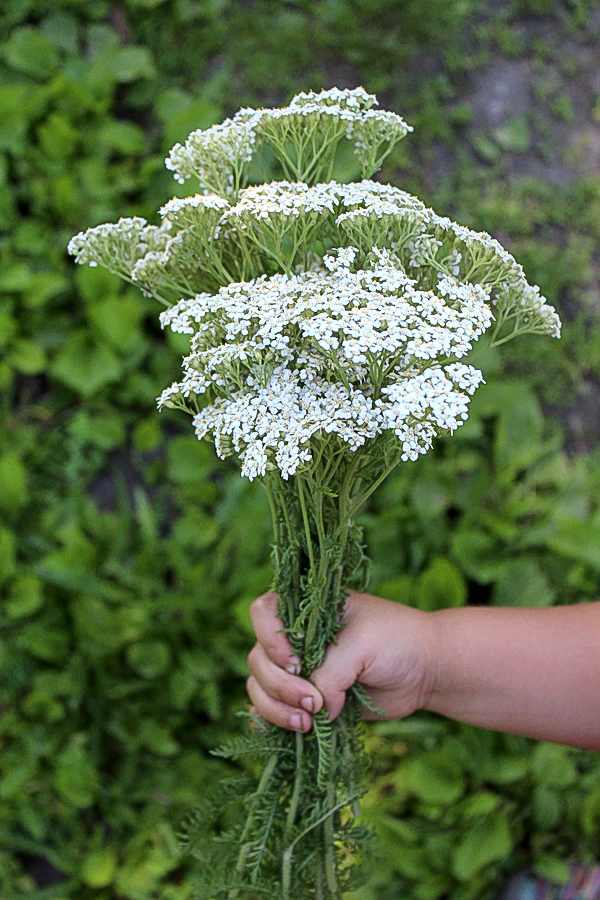
Wild Carrots (Daucus carota)
Queen Anne’s lace or wild carrots are a biennial, and the roots can be harvested in the early spring. As soon as you see the leaves pop up, dig down and harvest the sweet spring roots. Be careful because they can look a bit like water hemlock, and that’s a mistake you only make once.
Linden Leaves (Tilia sp.)
Every part of linden is edible, and the leaves grow in abundance in the spring. They’re best when they’re very small and light green before they’ve reached full size.
I’m hoping to make some linden leaf dolmas soon, but for now, I can vouch for them as a tasty salad green. Later in the season, you can harvest the blossoms for a delicious medicinal linden tea.
While linden leaves are great in salads, the tightly curled linden leaf buds are an especially delicious treat. They taste like sweet green peas right off the tree, and they definitely please a crowd when you’re foraging with kids.
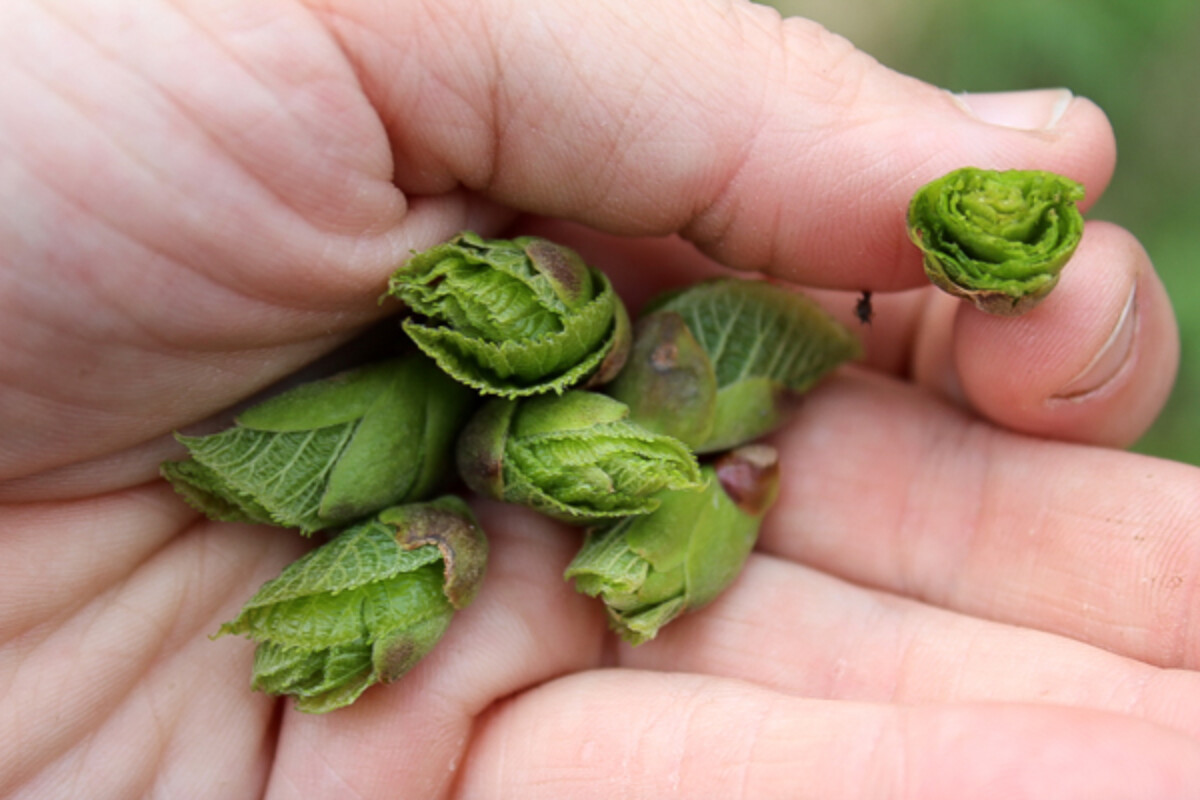
Tree Sap
Most people know that you can tap maple trees for syrup, but they’re only one of many trees you can tap for syrup. Nut trees like black walnut produce nuts later in the fall, but they can be tapped for syrup early in the spring. Other trees, like linden, shagbark hickory, ash, elm and dozens of others make tasty syrup.
You don’t need an expensive sap boiler, there are plenty of ways to make syrup without an evaporator. Just follow the same basic instructions for making maple syrup when working with other tappable trees. Even if you don’t bother boiling it down to syrup, the sap is tasty and certain types, like birch sap, are highly medicinal.
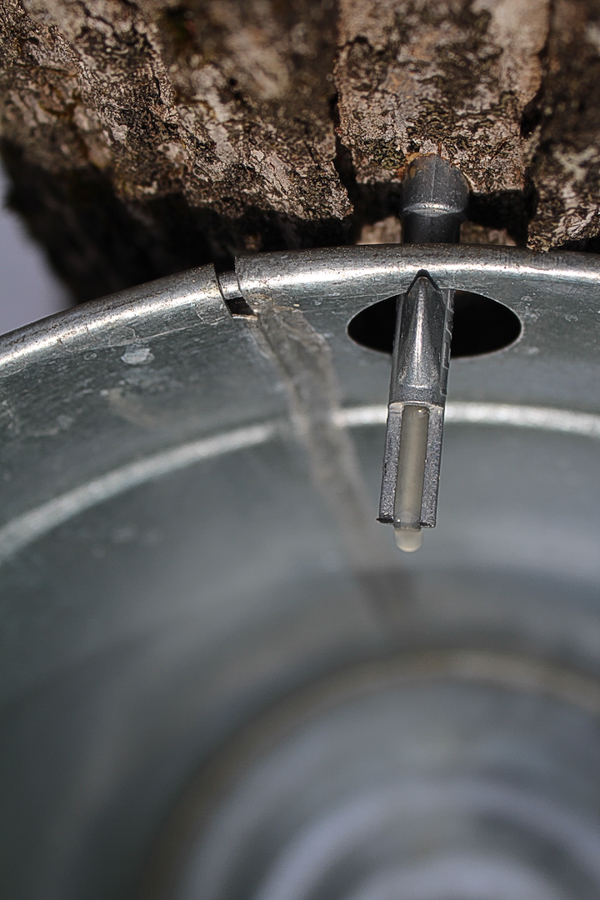
Other Foods to Forage
Beyond plants, there are a number of early spring mushrooms like morels that can be harvested if you know how to identify them. While you’re out foraging, keep an eye out for blossoms on wild apple trees, wild plums and juneberries. They aren’t ready yet, but if you mark the location, you’ll know where to find them in a few months.
What’s your favorite thing to forage in the spring? What did I miss? Leave me a note in the comments.
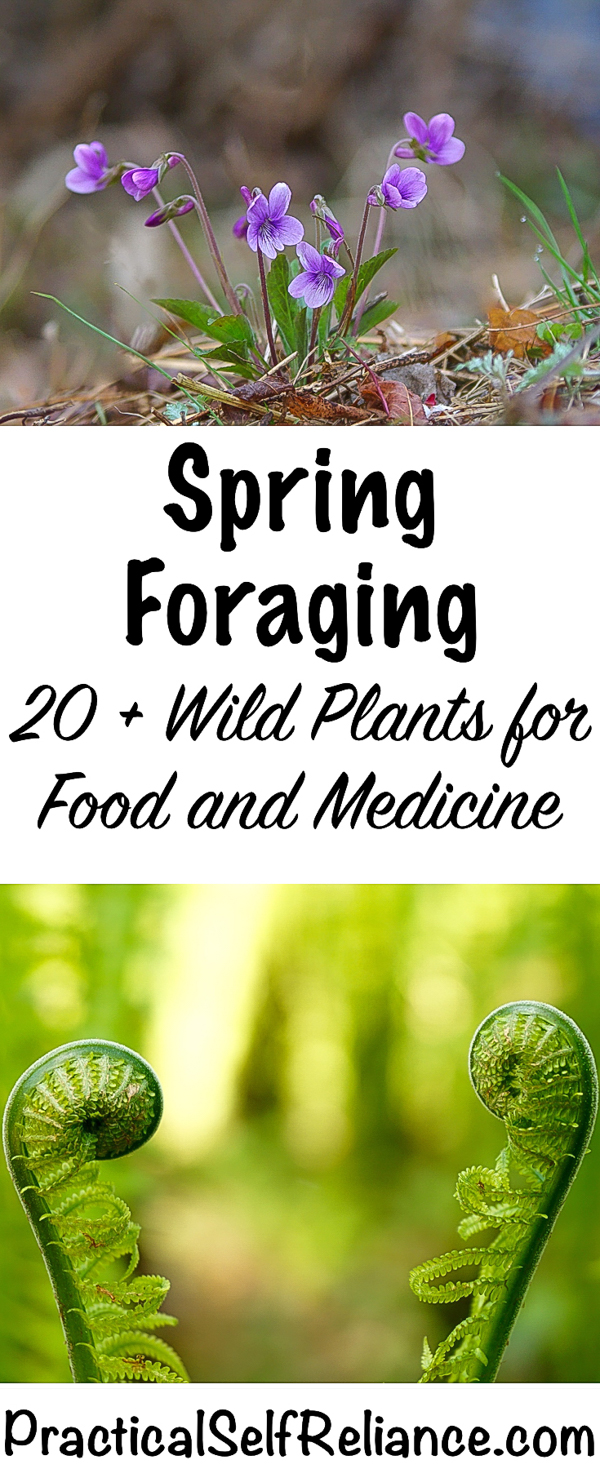














Great article Ashley! Here on the Olympic Peninsula people harvest maple flower buds and purple dead nettle.
Oh that sounds delicious!
I totally enjoyed the article. When I forage I look at everything. Now I know what’s good, and what to avoid. I am so hoping to find the prized morels it has been a cold rainy spring, so maybe. Next month the wild asparagus comes up nothing like that taste. I am spoiled now forever. Thanks for the great info! Carroll
You’re very welcome. We’re so glad you enjoyed the article.
I have a “guerilla foraging” question!
Creeping Jenny (Lysimachia nummularia) can be found all over North American landscapes, and every source I can find notes that a tea can be made from the leaves and flowers.
If tea can be made from the leaves, is there any reason why the leaves could not be consumed fresh or as a potherb? Is there something about the tea-drying process that would make this plant more edible than it otherwise would be?
Thank you for your thoughts.
It may just be because of the strong flavor of the leaves.
Ignore some of the comments . I love leeks and the bulb is tasty . I always leave some so they can spread .
The way you’ve harvest those leeks is unsustainable. I would suggest replacing your picture with one that doesn’t depict unsustainable harvesting practices. You need to cut above the bulb and just take a few leaves from the plant (not all) when harvesting wild leek.
Honestly it depends on where you are harvesting from. I live in an area so remote that people are hired specifically to pick (whole plant) a certain number of ramps to help keep numbers in check. Those plants are then used in local dishes cooked by mountain men and women which are then sold to the public to raise money for local schools. There’s many reasons one may use the entire ramp, and many ways to do it sustainably. You can not lump all geographical areas and say “that’s unsustainable”.
If you have another encounter with nettles, look for dock growing nearby. I’ve had great results gently rubbing the crushed leaves on the nettle rash, both to ease pain and inflammation. Worth researching, and as always, your mileage may vary.
One of my childhood memories is going early spring greens foraging with my mother. Like you, she knew what plants to look for, and would cook up a wonderful dish of spring greens as a result. One thing I remember she would pick is the young tender shoots of green briars.
Great article and super informative!
Can you maybe change the picture of your daughter holding an armful of ramps? Nothing against you or her, but pulling them up by the roots is extremely bad. You mention that they should be harvested sustainably…but pulling them up by the roots is exactly what you *shouldn’t* do if you want to harvest them sustainably, particularly given how popular ramp foraging is becoming. They take an extremely long time to produce seeds (5-7 years), and so they’re being slowly wiped out across the nation by folks who go on rampages (pun intended) and pull them up by the roots. Instead, take a sharp knife and cut one leaf. If you really want the bulb, leave enough of the roots so it can regrow.
Here’s an NY Times article to back me up, but you can find plenty of other info if you search for “sustainable ramps harvesting”: https://www.nytimes.com/2011/04/20/dining/20forage.html
Another article: https://www.wildedible.com/blog/foraging-ramps
Thanks again for a great article.
You should come near where I live, there are lots of ramps, and nobody picks them. They are very tender these days. Later, they will get tougher.
Honestly it depends on where you are harvesting from. I live in an area so remote that people are hired specifically to pick (whole plant) a certain number of ramps to help keep numbers in check. Those plants are then used in local dishes cooked by mountain men and women which are then sold to the public to raise money for local schools. There’s many reasons one may use the entire ramp, and many ways to do it sustainably. You can not lump all geographical areas and say “that’s unsustainable”.
Of course it makes a difference where the harvesting is done. I agree that at the very least, sustainable harvesting should be clearly mentioned in the article because not everyone has a huge, ready supply of them without needing to be concerned with sustainability. Those people who don’t know and understand the growth patterns of ramps need to be informed so that they can be responsible. So please explain the need for and how to be sustainable in practise.
I’m new to your newsletter and am enjoying it very much. I would like to see the botanical names included along with the common names, if possible. It makes it easier to do further research and can aid in identifying a plant that your not sure of. Keep up the good work! Happy Spring harvesting!
Really great idea! I’ve gone through and added scientific names for all the plants listed in the article. Thanks!
I thoroughly enjoyed this article! Now I will need to get my information together on how to positively identify some of these plants that are not so familiar to me so that I can avoid poisoning! Thank you for your wonderful contribution 🙂
What a superb list of spring forages!
I am curious which type of fiddlehead you recommend as there are a number of different varieties and I know some of them are carcinogenic.
As well, is second year burdock when the plant develops leaves and thistles?
The fiddlehead we forage here is known as Ostrich Fern (Matteuccia struthiopteris) but I believe there are other varieties in other regions that are also edible beyond just ostrich fern. You are correct, some species are toxic, but generally they look very different…just make sure you have a positive ID.
As to Burdock, yes it is the second year burdock that puts out the thistles (both years have leaves). It’s a biennial plant, so nutrient accumulation and small growth form in the first year, and then flower stalk in the second year.
This was absolutely a very interesting read and I would appreciate more information on the edibles of the woodlands .
Thank you. Cathy.